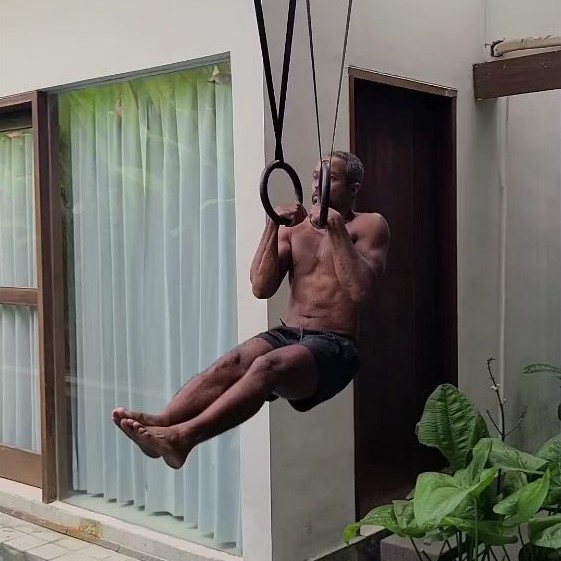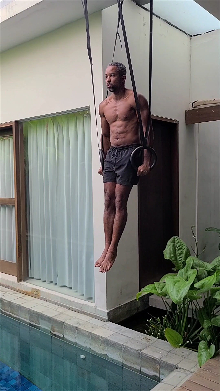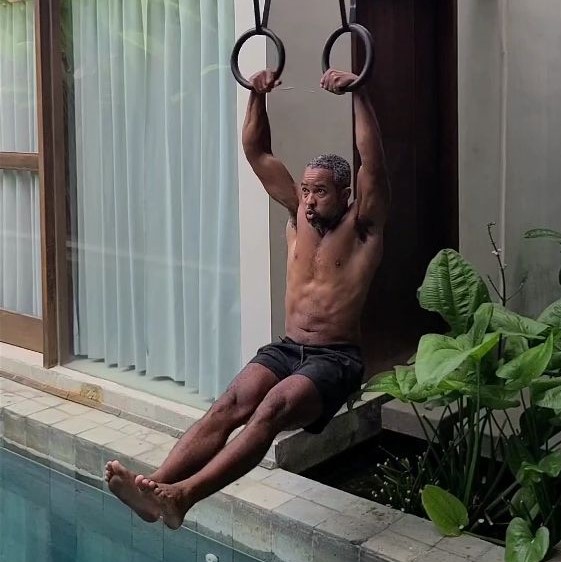Learning the false grip is essential to mastering ring muscle ups and stepping up your calisthenics capabilities and the strength, explosive power, and muscle you develop during your daily calisthenics training.

In this article, we’ll review what the false grip is, why the false grip is essential for mastering calisthenics on the rings and for muscle-ups, and exactly how to master the false grip technique and build up your false grip strength quickly, effectively, and safely.


CONTENTS OF THIS FALSE GRIP GUIDE
- What is the false grip
- Why is the false grip beneficial for ring muscle ups and in calisthenics?
- Should you use the false grip?
- How to perform the false grip
- How to train and progress in the false grip
- The False Grip in Action: False Grip Muscle Ups
- The False Grip in Action: False Grip Pull-Ups
- False Grip Frequently Asked Questions

WHAT ARE THE THREE-RING GRIPS: FALSE GRIP, NEUTRAL GRIP, AND GRIP FROM ABOVE
We can take three types of grips in doing exercises on the rings: the False Grip, Neutral Grip, and Grip from Above.
**
Neutral Grip
The neutral grip is the natural grip that we commonly take when grabbing rings, a bar, or anything. In the neutral grip, the rings sit directly across the palm and the knuckles as we hang below the rings.
The neutral grip is common however it places us in a more difficult position for transitioning from below to above the bar.
**
Above Grip
The “Above Grip,” or the grip we take when our body and arms are above the rings is the grip we naturally take at the top of a dip.

In the above grip, or forearm and slightly bent yet flexed wrist stack above the ring as our weight rests in the heel of the hand.
False Grip
The last grip is the false grip, a variation of the neutral grip that we take when hanging from rings that makes the performance of muscle-ups and other advanced calisthenics much easier, smoother, and more controlled.
WHAT IS THE FALSE GRIP
The false grip is a method of holding and hanging onto gymnastics rings in gymnastics and calisthenics wherein the bar is “hooked” just above the wrist using the heel, lower corner and side of the hand, instead of the normal “neutral grip.”
This grip places pressure on the heel of our hands. This grip also effectively “shortens” our arm, placing the rings closer to our body and elbow and making the transition movement of the muscle-up easier. During the muscle-up, at the top of the pull up portion of the movement, this naturally places our chest higher in relation to the rings, which also makes the transition from the top of a pull up to the bottom of a dip much easier
Using the false grip places the arms and body in a better position, closer to the rings, allowing for a smoother, more controlled transition during ring muscle-ups.
If you don’t have a pair of gymnastics rings at home, our need some for travel, click here to check out our instructional guide for making your own portable, simple to setup gymnastics rings to use anywhere.

WHY IS THE FALSE GRIP BENEFICIAL FOR RING MUSCLE UPS AND IN CALISTHENICS?
The false grip eases the transition from the bottom of the top of the pull up to the bottom of the dip, by shortening the distance we must pull
A proper, controlled muscle-up requires pulling the rings down to the bottom of the chest before we can transition to the bottom of the dip. Keeping the rings hooked at the level of the wrists, in the false grip, instead of at the knuckles, as we do with the neutral grip, naturally, raises our body and reduces the distance we have to travel.
**
You will not be able to do a proper, efficient, and healthy pull up if you cannot pull and hold with the rings at chest level.
The false grip reduces the length of the “lever” of your arm, making moves like the iron cross and front lever slightly easier
The further your body is from the rings, the more difficult it will be, even by mere inches. Using the false grip, holding just above the wrist instead of far at the knuckles, makes any “levered” movement on the rings easier
This in turn shortens the range of movement in exercises which, again, makes them slightly easier.

SHOULD YOU USE THE FALSE GRIP?
If you intend to advance in calisthenics training, you should absolutely train the false grip for better technique and more strength.
Being able to do the false grip allows you to transition from intermediate movements, like pull ups and dips, to advanced movements, like the muscle-up and iron cross. You will likely not be able to do the muscle-up smooth and controlled, without kipping, unless you’ve mastered the false grip.

HOW TO PERFORM THE FALSE GRIP
To set up in the false grip, follow these instructions:

- Place your open hand through the ring with palm up.
- Place the inside of your palm against the upper corner of the ring at the side of the inside of your palm. You should grab at roughly the “10:00 position” with the right hand and the “2:00 position” with the left hand
- Wrap your fingers around the ring, starting with the pinky and continuing across your fingers until last you wrap with your thumb
- Rotate inward and pull down on both rings, placing pressure on the heel of your hands and flexing your wrist to curl your hand inward.
Boom. You are setup in the false grip.

HOW TO TRAIN AND PROGRESS IN THE FALSE GRIP
To train the muscle-up, we want to start with mastering the technique behind the movement, setting up correctly and getting the wrist placement as good as possible.
After our technique is solid, we will develop strength by gradually extending the time we can hang in the false grip and gradually increasing how much weight we place on our wrists.
Finally, we will have enough strength and technique to perform pulling movements with the false grip.

HOW TO TRAIN PROPER FALSE GRIP TECHNIQUE
Start training the false grip technique by repeatedly setting up as described above, until the grip feels right, hooked and supported at the heel of the hand.
Once you are in position, hanging from low rings, extend your legs slightly with feet resting on the ground with your body in an “L” position, partially supported by the ground, and partially supported by your false grip on the rings.
**
To begin training, aim to hang from the false grip supported for 20 seconds, 3 separate times. Gradually increase until you can hang for a full minute supported.
From here, your technique should be good enough, and we’ll progress to training strength in the false grip – adding weight.

HOW TO TRAIN FOR MORE STRENGTH IN THE FALSE GRIP
We will continue with static holds (no pulling) to train strength, increasing how long we hang until we’ve reached 1 minute of supported hanging.
From here, gradually change position, raisining the height of the rings and the positioning of your body so that your false grip supports more weight and less weight is supported by your feet. Continue progressing until you are hanging freely, with your feet unsupported.

Once you are hanging unsupported, aim for a 30 second free hang with the false grip. Once you’ve achieved this, use the false grip for your pull ups, to train supporting even more resistance with your grip.
Last, continue to muscle up progressions using your false grip.

TIPS FOR MASTERING THE FALSE GRIP
- Take it slow: The false grip not only involves forearm and wrist strength, it also involves adaption of tendons, desensitizing sensitive areas, and gaining the coordination in your lower arm. This process will not happen as quickly as muscle strength adaption. To avoid frustration, injury, and unnecessary pain, take it slow and listen to your body’s “go ahead” sign before progressing.
- Use low intensity progressions to focus on form: Low intensity progressions, such as hanging from the rings with your feet on the floor to lighten the load while adjusting to the technique and finding the “sweet spot” for you. Stay at the lower levels of progression, simply hanging with assistance, until the technique feels right – don’t worry about progressing earlier.
- Use static holds to train: In the beginning, don’t worry about pulling (doing pull ups or rows) in the false grip. Just aim to hang for repeated periods of 20 to 30 seconds. This will train strength in the technique and give you the free focus to critique your technique, without the risk and distraction that comes from dynamic movements.

FALSE GRIP FREQUENTLY ASKED QUESTIONS
Is the false grip bad on your wrists?
Any exercise in excess, without proper joint and muscle care can be “bad.” However with proper progression, warmup before training, stretching, mobility, and recovery actions and wrest time between training the false grip, the false grip is low risk, worth training, and guaranteed to expand your calisthenics skill set and capabilities.
Is false grip dangerous?
As long as you train the false grip with proper progressions, developing adequate strength and time for recovery before increasing difficulty, the false grip is not dangerous.
How do you practice and improve my false grip?
First, focus on mastering the false grip technique which includes 1) mounting into the false grip effectively and 2) “hooking” the rings under the wrist in that perfect spot. Second, train strength – essentially how much weight you can hold and more importantly how long you can hang – in the false grip. To train strength in the false grip, do repeated, and progressively longer static hangs while holding your body in a hollow body position from the rings using a false grip
Why should you use a false grip instead of neutral grip?
False grip places the rings closer to the body than the rings would be held in a neutral grip. This positioning makes the transition in the muscle-up, from the top of the pull up to the bottom of the dip, more natural, easier, and smoother, allowing for a slow controlled muscle-up, instead of a kipping style pull up which relies on less controlled momentum to carry your body over the “hump” in the transition.

OTHER GREAT CONTENT
- Ring Muscle Up Tutorial and Ring Muscle Progressions Guide
- Essential Calisthenics Equipment
- 33 Great Parallettes Exercises to Balance Out Your Rings Workout


ABOUT THE AUTHOR
Carlos is a nomad, slow traveler, and writer dedicated to helping others live abroad and travel better by using his 7+ years of experience living abroad and background as a management consultant and financial advisor to help other nomad and expats plot better paths for an international lifestyle. Click here to learn more about Carlos's story.
